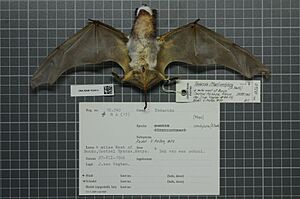Angolan free-tailed bat facts for kids
Quick facts for kids Angolan free-tailed bat |
|
|---|---|
 |
|
| Conservation status | |
| Scientific classification | |
| Genus: |
Mops
|
| Species: |
condylurus
|
| Synonyms | |
|
|
The Angolan free-tailed bat (Mops condylurus) is a type of bat. It belongs to the Molossidae family, also known as free-tailed bats. You can find this bat in many countries across Africa. These include Angola, Benin, Botswana, Burkina Faso, Burundi, Cameroon, the Republic of the Congo, the Democratic Republic of the Congo, Ivory Coast, Eswatini, Ethiopia, Gambia, Ghana, Guinea, Kenya, Malawi, Mali, Mozambique, Namibia, Niger, Nigeria, Rwanda, Senegal, Sierra Leone, Somalia, South Africa, South Sudan, Sudan, Tanzania, Togo, Uganda, Zambia, and Zimbabwe.
These bats usually live in dry and moist savanna areas. Sometimes, they can also be found near the edges of forests.
Contents
About the Angolan Free-Tailed Bat
What Does It Look Like?
The Angolan free-tailed bat has soft, short fur. Its fur is brown, and its ears are black. Its wings are a dark brownish-black color. These bats also have wrinkled lips.
A special feature is their tail. About half of their tail sticks out beyond the edge of the membrane between their legs. This is why they are called "free-tailed" bats. From its nose to the tip of its tail, this bat is about 11.4 centimeters (4.5 inches) long.
Daily Life and Habitat
The Angolan free-tailed bat is a nocturnal animal. This means it is active at night. During the day, it rests in safe, hidden spots. These resting places are called "roosts."
They often roost in places like:
- Buildings made by humans
- Hollows inside trees
- Cracks in rocks
Where Does Its Name Come From?
A Scottish zoologist named Andrew Smith first described this bat in 1833. He gave it the name Nyctinomus condylurus. The second part of its name, "condylurus," likely comes from a Latin word. "Condyle" refers to a round bump at the end of a bone. Smith called the bat "knob-tailed," which might be why he chose this name.
Conservation Status
The Angolan free-tailed bat is doing quite well in terms of its population. In 2017, the International Union for Conservation of Nature (IUCN) looked at its status. They listed it as a "least-concern species." This means there are no major worries about this bat becoming endangered right now.


